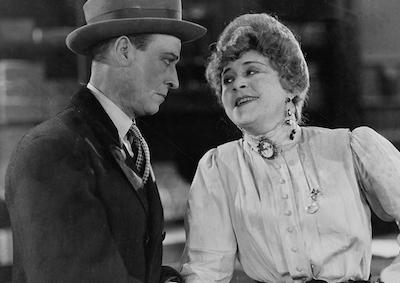Chameko's Day (Japan, 1931)
Chameko no ichinichi
This charming cut out animation, based on a popular children’s song first recorded in 1919, follows a day in the life of Chameko, a young girl who wakes up, goes to school and then attends the cinema with her mother.
Narrated by benshi Ōmori Kumiko.
Print courtesy of the National Film Archive of Japan. 35mm, b/w, silent, intertitles in Japanese with English subtitles, 7 min. Director: Nishikura Kiyoji.
The Sword that Slashes Human and Horse (Japan, 1929)
Zanjin zanba ken
Shochiku studios had introduced the term jidaigeki, that is “period drama,” into the Japanese theatrical marketplace in the early 1920s to describe and differentiate two of its films, Shimizu Jirocho and Woman and Pirates, both written by Itō Daisuke. While it launched the period drama, Shochiku didn’t pursue it, letting Itō go to Nikkatsu studios, where, as a director he revolutionized the genre with his own energetic take on the chanbara film. In a bid to make up lost ground, Shochiku lured Itō back with an unprecedented budget to shoot The Sword That Slashes Human and Horse about a ronin who comes to the aid of rebellious farmers against a corrupt feudal lord. As with Blood Spattered Takadanobaba, this short fragment will be repeated over the course of this series with a different benshi narrating each time.
Narrated by benshi Sakamoto Raikō.
Print courtesy of the National Film Archive of Japan. 35mm, b/w, silent, intertitles in Japanese with English subtitles, 26 min. Director/Screenwrite: Itō Daisuke. Cast: Ryunosuke Tsukigata, Misao Seki, Kanji Ishii.
Silence (1926)
This Cecil B. DeMille production directed by Rupert Julian (The Phantom of the Opera) was believed lost until a nitrate print turned up in Paris. Waiting on death row, Jim Warren (H. B. Warner) recalls the series of tragic events and malign efforts, including his wife’s apparent betrayal, blackmail and murder, that led to his fate. Considered lost for a long time, Silence was rediscovered in 2016 in the collections of the Cinémathèque Française. The tinted 35mm nitrate print was shorter than the American version of the film. All crossed sources showed that the missing part concerns a masked subplot, covered in the French version by an intertitle. For ethical but also practical reasons, the film restored in 2017 by the Cinémathèque Française and the San Francisco Silent Film Festival does not show nor re-translate the missing part. It represents the version released in France.
Narrated by benshi Kataoka Ichirō.
Print courtesy of the Cinémathèque Française. 35mm, b/w, silent, 96 min. Director: Rupert Julian. Screenwriter: Beulah Marie Dix. Cast: Vera Reynolds, H. B. Warner, Raymond Hatton.
Not Blood Relations (Japan, 1916)
Nasanu naka
Based on a contemporary set novel by Shunyo Yanagawa, Nasanu Naka (Not Blood Relations) was adapted to the Japanese stage with multiple film versions to follow, including director Naruse Mikio’s take in 1932. Director Masao Inoue also stars in this 1916 adaption which follows the destruction of a businessman and his family as mounting scandals reakwaken lingering hatreds and induce new crimes. This surviving fragment features three sequences from the original film, including its denouement.
Narrated by benshi Kataoka Ichirō, Sakamoto Raikō, Ōmori Kumiko.
Digital video, b/w, silent, intertitles in Japanese with English subtitles, 12 min. Director: Masao Inoue. Cast: Masao Inoue, Kichinosuke Kinoshita, Kikuya Akimoto.






 Mobile Navigation
Mobile Navigation

